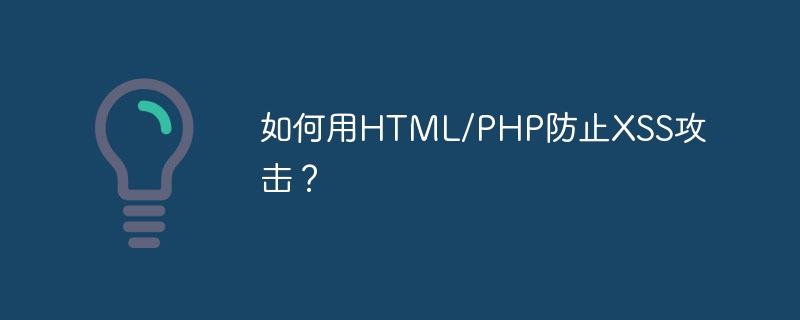Home >Backend Development >PHP Tutorial >How to prevent XSS attacks with HTML/PHP?
How to prevent XSS attacks with HTML/PHP?
- 王林forward
- 2023-09-09 19:41:021653browse

Cross-site scripting (XSS) is a major threat to web application security because it allows attackers to inject malicious scripts into reputable websites. This attack relies on innocent consumers to expose vital information or potentially gain control of their accounts. As web applications become more complex and dynamic, understanding and combating XSS threats is critical to maintaining a strong security posture. In this article, we’ll take a closer look at XSS attacks and look at possible prevention strategies.
What is an XSS attack?
Cross-site scripting (XSS) attacks are a common security risk in web applications. Attackers exploit vulnerabilities in web pages to inject and execute malicious scripts on unsuspecting users' browsers. Developers can protect their applications and users by understanding the various XSS attacks and how they can be exploited.
Different types of XSS attacks
Reflected XSS - Reflected XSS occurs when user-supplied data is immediately included in the output of a web page without being adequately sanitized or encoded. Attackers create malicious URLs or forms to trick users into unintentionally executing an injected script. The script runs in the victim's browser, allowing the attacker to steal sensitive information or perform unauthorized actions.
Stored XSS - Stored XSS, also known as persistent XSS, involves injecting malicious scripts that are permanently stored on the target server. These scripts are then served to users who visit a specific web page or resource. When unsuspecting users view these pages, the injected scripts are executed, potentially compromising their accounts or exposing sensitive data.
DOM_Based XSS - DOM-based XSS attacks target the Document Object Model (DOM) of a web page. Rather than modifying server responses, attackers exploit flaws in client-side JavaScript code to insert and execute malicious scripts. Malicious code interacts with the DOM, changing page content or stealing critical data.
How are XSS vulnerabilities exploited?
XSS vulnerabilities can be exploited in a variety of ways, depending on the type of attack and the environment in which it occurs. An attacker can use the following methods -
Inject script tags or event handlers into user input fields, comments, or chat messages.
Use JavaScript functions and objects to run arbitrary code.
XSS vulnerabilities can be triggered by manipulating URL parameters or form inputs.
By understanding the mechanics of XSS attacks and the different exploitation possibilities, developers can better find and resolve vulnerabilities in online applications.
XSS Prevention Technology
We use a variety of techniques to prevent XSS attacks on our site. The technology is as follows -
Input validation and sanitization
Input validation is a critical step in filtering and sanitizing user input. Use whitelists (allow only specific characters or patterns) or blacklists (protect against known harmful input). Here are some common functions for input validation and sanitization -
filter_var() - Provides a comprehensive set of filters for validating and sanitizing different data types. It allows you to perform tasks such as validating email addresses, sanitizing URLs, validating integers, and more.
strip_tags() - Removes HTML and PHP tags from strings, effectively sanitizing the input and preventing potential script execution. It is useful when you want to allow certain HTML tags but remove any potentially harmful tags.
preg_replace() - Allows you to perform regular expression based search and replace operations. It can be used for advanced input sanitization tasks, such as removing or replacing specific patterns or characters from user input.
strlen() - Returns the length of the string. It can validate the length of user input and enforce certain length limits.
addslashes() - Adds backslashes before characters with special meaning when querying SQL or processing data stored in the database.
Output encoding
It is important to encode the output to avoid the script from executing correctly. Use functions such as htmlspecialchars() to convert special characters into corresponding HTML entities to ensure safe display of user-generated material. Here are some examples of how to use htmlspecialchars() to prevent XSS -
"&" (ampersande) becomes &
‘"’ (double quotation marks) becomes “
‘>’ (greater than) becomes >
‘
"'" (single quote) becomes ' or '
Content Security Policy (CSP)
Implement a Content Security Policy (CSP) to specify trusted content sources. Define directives like "default-src 'self'" to limit resources to be loaded from the same source, reducing the risk of executing malicious scripts.
Example
header("Content-Security-Policy: default-src 'self'");
This example uses the Content-Security-Policy header to enforce the default-src directive of "self", which allows resources to be loaded only from the same source, thus preventing unauthorized script execution. There are many other resource directives we can use.
以下是内容安全策略中的一些常用指令 -
script-src - 定义可以加载或执行 JavaScript 代码的源。
style-src - 定义可以加载样式表的源。
img-src - 指定可以加载图像的源。
connect-src - 定义可以发出网络请求的源,例如 AJAX 调用或 WebSocket。
font-src - 确定可以加载网络字体的来源。
frame-src - 指定可以嵌入框架或 iframe 中的源。
object-src - 指定可以加载嵌入对象(例如 Flash 或 Java 小程序)的源。
使用准备好的语句和参数化查询
SQL注入是一种可能导致XSS漏洞的典型攻击类型,可以通过准备好的语句和参数化查询来防止。这些策略通过将用户输入附加到占位符来确保数据和代码分离。示例
$stmt = $pdo->prepare("SELECT * FROM users WHERE username = ?");
$stmt->execute([$username]);
在此示例中,我们通过将用户输入与 SQL 代码分离来防止 SQL 注入攻击。
第三方 PHP 库
这些库旨在使安全措施更易于部署,并针对潜在漏洞提供强有力的防御。以下是一些用于预防 XSS 的流行第三方 PHP 库 -
HTMLPurifier - 一个功能强大的库,可以过滤和清理 HTML 输入以删除潜在的恶意或不安全代码。它确保只允许安全有效的 HTML,防止通过受污染的用户输入进行 XSS 攻击。
AntiXSS - 由 Microsoft 开发的库,提供对用户输入进行编码以减轻 XSS 漏洞的方法。它提供了针对各种上下文(例如 HTML、JavaScript、URL 和 CSS)对用户生成的内容进行编码的功能。
PHP 安全建议 - 一个 Composer 插件,用于扫描项目的依赖项以查找已知的安全漏洞。它有助于识别具有已知 XSS 漏洞的库,并建议更新到安全版本。
HTMLSafe - 提供安全、上下文感知的 HTML 输出的库。它通过根据显示输出的上下文自动应用适当的编码来防止 XSS 攻击。
在本文中,我们研究了防止 HTML/PHP 中 XSS 攻击的各种方法。通过应用此类措施并使用多个众所周知的函数,您可以有效地保护您的 Web 应用程序免受 XSS 漏洞的侵害。
The above is the detailed content of How to prevent XSS attacks with HTML/PHP?. For more information, please follow other related articles on the PHP Chinese website!

